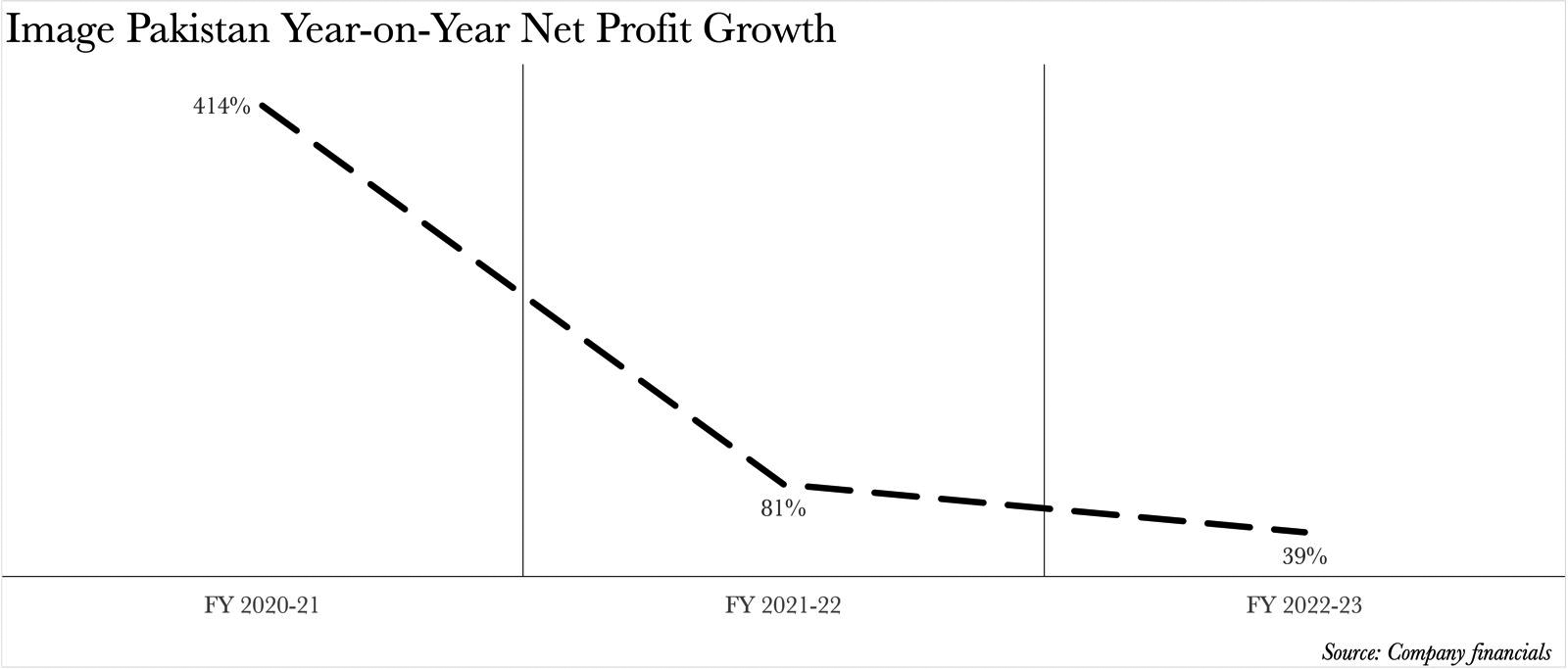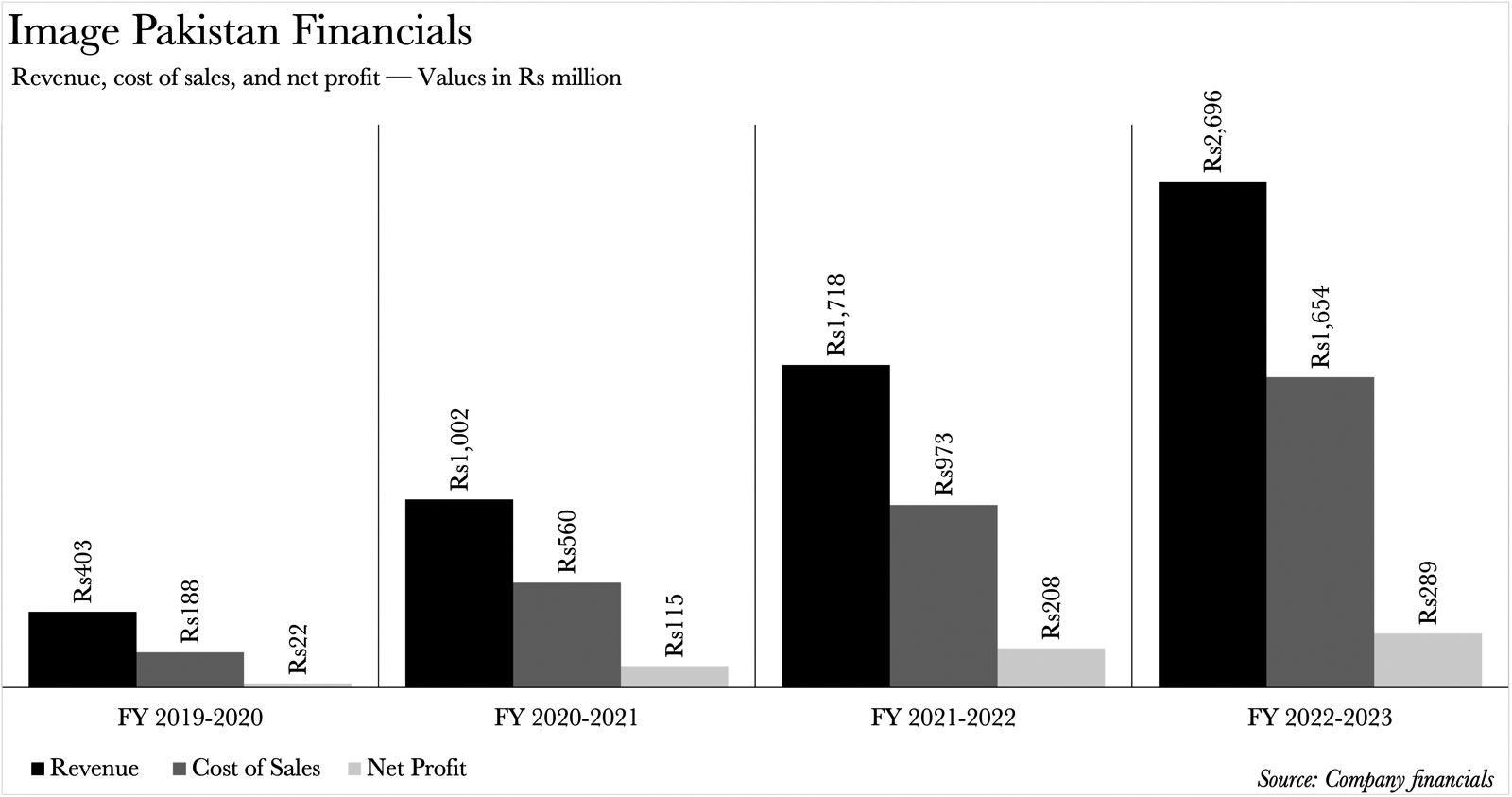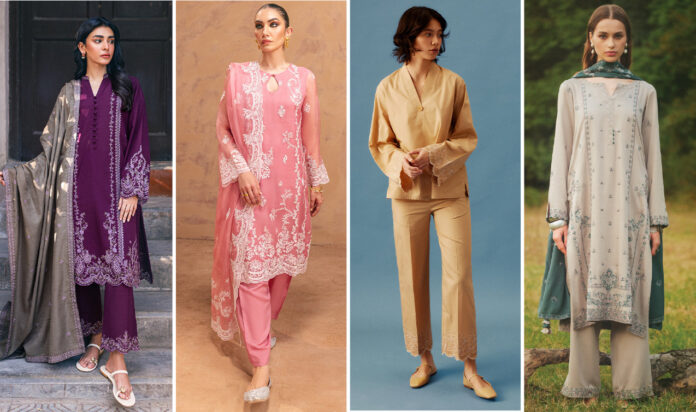For those of us born in the 1990s and early 2000s, the memory of tagging along with our mothers to Portia, where we would get lost between massive thaans (fabric rolls) of the best quality branded lawn fabric, along with three different counterfeit options adorning the store, seems like a fever dream now. Some of us can’t remember the last time we stood inside an almost claustrophobic little shop in Qurtaba market, dripping in our own sweat trying to find laces that would best compliment the fabric we just purchased. Even worrying about whether our tailor would be able to bring our vision for the outfit to life seems like a trouble from a past life.
Today, the ritual of personally selecting fabrics is usually preserved for the wedding season. Instead, for everyday clothing, the focus has shifted to a singular, all-encompassing term: Pret. The word directly translates to ‘ready’ and more commonly called ready-made or ready-to-wear when referring to clothes.
But there was a time when everything was not conveniently available on the racks for immediate trial. So, when did we go from selecting fabrics, laces and buttons to simply picking a kurta off a rack, trying it on and if it fits, viola! The answer is: sometime around 2010. This new era of fashion, spearheaded by the advent of pret, forced everyone to adapt – buyers and manufacturers alike.
Such is the story of Image, which started as an embroidered fabric manufacturer 30 years ago. In 1993, Asad Ahmed and Farnaz Ahmed founded Image, which sold high-quality embroidered fabric as wholesalers to clients, like Saleem Fabrics and Portia. It wasn’t until 1998, when the first Image store was established at Zamzama, which still exists today.
With the launch of its first store, Image stepped into retailing its fabrics through its own stores, going onto expanding its network to 11 stores and it is paying off: this year, the company’s net profit stood at Rs 288.6 million. How did they do it?
Let’s take a closer look at Image’s journey in the last 30 years, along with the changing landscape of fashion and the subsequent expectations of consumers in these last three decades.
Retail to the rescue
Image has evolved into a clothing brand that caters to a large majority of buyers, with its minimalistic designs and simple but trendy cuts. Profit sat down with Marium Ahmad, Director at Image Pakistan Limited, to talk about the journey of the company her parents started.
“Back in the 1990s, the patterns of buying were quite different from what they are now. The market was divided into two main categories, with 95% being unstitched fabric on the thaan and a culture of getting one’s clothes tailored, while only 5% of the market was for stitched ready-to-wear options,” Ahmad reminisces.
It wasn’t until the early 2010s, when Pakistani retail saw a massive shift and the landscape tremendously changed. According to Ahmad, “This was mainly due to the growing presence of malls. When shopping became part of the country’s recreational culture, brands also started erupting. In the wake of this cultural shift, a ready-to-wear concept also emerged.”
There is also another factor at play: the rise in the demand for work clothes. A 2023 study on the Patterns and Causes of Female Labor Force Participation: An Age–Period–Cohort Analysis for Pakistan reveals female participation in the labour force has grown by 9% in the last three decades.
Faiza Ali, Associate Professor of Business Management at LUMS, noted that in an economic crisis like the current one, with monthly inflation surging to 26.9% year-on-year as of October 2023, many women are left with no choice but to enter the workforce, as it it is becoming increasingly impossible to run a household with one income.
So, there is not just an increased demand for semi-formal and work-friendly attire, but also decreased time on women’s hands to spend time designing and getting their clothes made from scratch.
“My observations and numbers show that younger audiences, especially the growing Gen-Z demographic, are more involved with work and their role now not restricted to just being a housewife, has shifted priorities, so they have a greater demand for pret,” relays Ahmad.
She believes this shift in overall consumption trends was driven by, “Young audiences, essentially urban women, such as office going girls, as well as, young and middle-aged mothers, who started looking for a hassle-free experience, without having to compromise on good designs and aesthetic, while at the same time not being charged an arm and leg for it.”
Ahmad explains, “The concept of designers was there before but going to a designer boutique meant two things: firstly, it used to be order-based and secondly, going down this route was extremely expensive. Buying designer outfits back in the day meant you had to pay a lot of money.”
Even before malls became mainstream, many clothing brands were already gearing to jump on the bandwagon of fashion retail, with Khaadi, Generation and Ideas by Gul Ahmed being at the forefront of the revolution and multiple stores across Pakistan. This was followed by brands that started dabbling with niche designs: think of Huma Adnan’s Fnkasia, Sefam’s Rang Ja and EGO, all of which cropped up between 2004 and 2012.
This shift did not go unnoticed at Image. Ahmad shares that towards the end of 2016, Image was transformed from being just a fabric manufacturing company into a fashion house. “When we dabbled with fashion, we saw a good response and there on our journey took off. From having one store till the mid 2010s, to having eleven stores across the country, not to mention our e-commerce presence, we have come a long way,” Ahmad exclaims proudly. The brand is set to launch another store in Lahore soon.
From the looks of it, the company is doing quite well financially too. Revenue growth over the last three years has been quite spectacular, with 149% increase in revenue from fiscal year 2020 to fiscal year 2021 and 72% revenue growth in fiscal year 2021 to 2022. Image recorded a 57% growth in revenue in the last financial year ending June 2023.

In the last fiscal year ending 2023, Image recorded a net profit of Rs 288.6 million, which was a 39% increase from the preceding financial year ending June 2022. The company’s net profit surged by a whopping 414% in fiscal year 2021 and 72% in fiscal year 2022.

Image’s trajectory of growth in terms of both revenues and net profits is evident and the trend seems to be continuing in the future. The financial year 2024 already looks promising, with a net profit of around Rs 132.7 million recorded in the last quarter ended September 2023.

Ahmad insists that the main focus of Image has always been to maintain the quality it is known to have, while catering to a large demographic. She explains why it is important to keep the old school loose fabric segment alive: “Despite pret getting preference from a large segment of buyers, our unstitched segment is still popular because for a certain age and above, as well as for gifting purposes, people still like buying unstitched fabrics. I believe there are two kinds of women: those who have a vision and possess the ability to make trips to their tailor, explaining what they want and getting the desired output. But then there are also those, who have absolutely no idea how to translate their vision for an outfit to a tailor and even the most beautiful fabric can’t save the outfit from looking like a disaster.”
Even though Image has an array of categories, from daily wear to embroidered chikankari and raw silk,, Ahmad insists they are not a fast fashion pret brand. And this is what, according to her, sets Image apart from other clothing brands.
“The concept of image is not that of fast fashion. Instead, we are everlasting fashion, we are giving you value for money, which is why our prices are also higher and we charge a premium. We get to have our prices because our product is not compromised in quality, our fabrics can be worn for the next five and would still look new after several washes– this is something you don’t see in other brands,” says Ahmad.
The other factor that distinguishes Image from other fashion brands is their designs. “We make classic and evergreen designs, staying cognizant that Image’s identity and brand philosophy is to create products that are timeless and you are unlikely to get sick of it, unlike the fast fashion fad that would go out of fashion in less than three months,” explains Ahmad. She believes that every article of clothing you purchase from Image is an investment in your wardrobe.
The metaverse of fashion retail
We live in a society where phrases, such as “When things get hard, add it to the cart” have become part of the lingua franca of younger generations. Consumer behaviour did not just shift from getting clothes tailored to buying pret, but also witnessed a retail to e-commerce shift over the years.
A 2021 report by Euromonitor International forecasts the sales performance of apparel and footwear retailers to dip by approximately 5% from 2022 to 2026. The same report, however, reveals a trend of growth in the retail value of e-commerce shares for Pakistani retailers, such as Gul Ahmed and Khaadi over the past five years. Despite a downturn in consumer spending in traditional retail due to a high inflation rate, year-on-year online shopping appears to have been resilient to inflationary pressures.
According to an industry source from a major clothing retail brand, consumer research indicates a preference for the convenience of online shopping over the time-consuming experience of browsing through physical stores. This trend suggests a decline in the appeal of traditional retail stores and the creation of a metaverse of fashion retail. Some small businesses, most of which popped up during the pandemic, are turning into successful e-commerce stores, without the need for a brick and mortar presence. Stores like PELAGO, The Sassy Store, Inclusivitee and Ayesha Accessories are a few examples.
To cater to this new segment of online shoppers, Image has also developed an online presence, not just in Pakistan, but also overseas, targeting the growing diaspora market. “Our current focus is on targeting the international market,” says Ahmad.
Because the company has only recently opened its doors to the international market, the local market makes up the larger chunk of Image’s revenue. Ahmad says that the international market makes up only 10% of the revenues, while the local market makes up the remaining 90%.
Ahmad explains how overseas shipping comes with a myriad of challenges and delays, including high international shipping costs, long delivery periods, even longer delays in cases of exchange or refund and issues with international transactions.
To combat these issues, in January 2022, they incorporated Tri-star Image (USA) Inc., which is an overseas subsidiary of Image Pakistan. The company has made arrangements for making delivered duty paid to enable scaling the company’s e-commerce volumes.
“If you are in the US and shopping on US.image1993.com, you will not be paying international shipping prices because we have entailed extra costs to set up a fulfilment centre in America,” says Ahmad.
With the establishment of the new fulfilment centre, here’s what you can expect as an Image customer in the US: you pay the regular delivery charges, you can opt for a free refund or get an item exchanged within four days, you won’t be paying import-adjusted prices or any custom duties and neither will you be required to go through the hassle of filling out know-your-customer forms.
Similarly, in November 2021, the company established Image International Limited, another overseas subsidiary in the UK. “So, we’ve taken care of the import headache in the UK, as well. The subsidiary means buyers won’t be importing anything because they would be locally buying from our presence in the UK,” says Ahmad.
The fact remains that with a rapidly depreciating rupee, the international market presents an opportunity to sell at better margins. Profit asked Ahmad whether the prices for overseas customers on their international e-commerce stores are different from the prices for Pakistani buyers. Ahmad said, “We are very competitive and our strategy for the international market is to keep the prices at a minimum but yes, we do have slightly higher prices for the international market. The current international prices are a 1.5 to 1.7 multiple of local prices, which gives us a margin, as well as covers the costs of setting up an international subsidiary and doing business overseas.”
Miss Image has made her debut
The fear of missing out, especially on creative experiments, is felt deeply at the Image headquarters. Perhaps that is why after Sapphire, Beechtree, Khaadi, ETHNiC, Gul Ahmed, Alkaram and many others, Image also launched a Western line called Miss Image on December 1, 2023. This collection mostly features matching separates, with an eastern spin, such as intricate desi embroidery on a co-ord set.
“With Miss Image, you will see the same Image aesthetic translated into fresher cuts for younger audiences,” Ahmad expounds.
Competition in this particular segment of ‘western’ outfits is fierce, with all pret players having their own collections of button-downs and peplum tops, bearing some semblance to eastern aesthetics through embellishments and bright prints. Image’s take on this segment is quite classic and minimalistic, complimenting the brand’s overall aesthetic.
Image has a fashion institute of its own, called the Imperial Tutorial College. The institute operates in collaboration with a Turkish university known as Nisantasi University. “We are the only brand that has a fashion-concentrated college, therefore we are also playing a role in producing talent for not just our own business, but for the country,” Ahmad adds. “Students get the chance to go to Turkey and study at Nisantasi for a year or two, as well, for an associate degree program or a full graduate degree program,” she concludes.
Ahmad has for too long felt that the country is in a desperate need for good resources and students in Pakistan lack proper education and training to work in fashion. Image’s fashion institute gives the company an inhouse platform to train and hire talent. Image doesn’t hire every graduate of their institute, so the school is also producing talent that goes on to work for other fashion houses.
“Even though the programs we offer are in collaboration with Nisantasi, we stress over the fact that talent in fashion needs to know how to make clothes for the local market, keeping cultural values, as well as, stylistic preferences in mind. How many people in the country actually wear gowns and dresses?” Ahmad poses rhetorically.
Success in fashion and clothing retail is not only limited to brands that have an impressive start and identify a niche early on, but also includes those who are quick to adapt to fast-changing trends, demands and the overall needs of a particular era. Image has proven to be just that, going from a fabric wholesaler, competing with the likes of Bareeze, to a fashion retailer that competes with prominent pret players and caters to the everyday needs of urban women today.
























